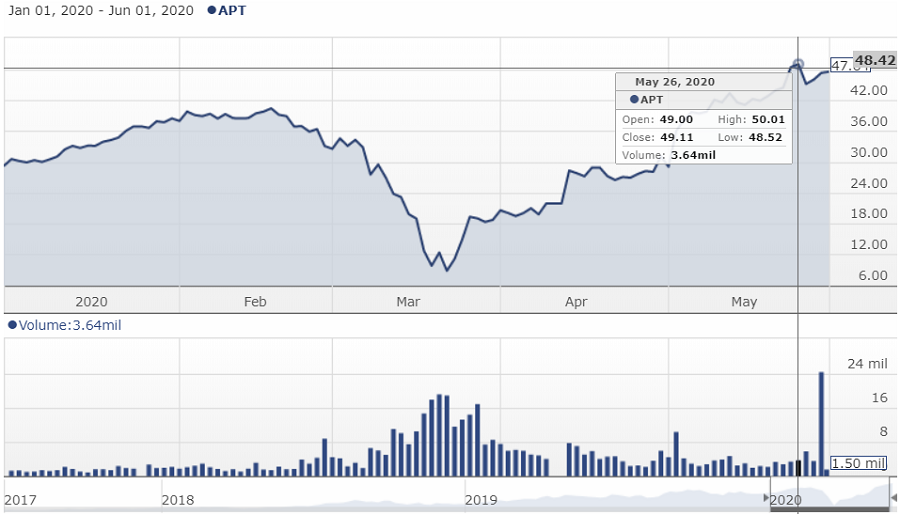Valuing a company is a difficult exercise at any time, but how do you pin down a stock that recently traded between $8 and $50 in the space of only two months? That’s the Afterpay (ASX:APT) experience. The sellers at $8 are gnashing their teeth and the buyers at $50 are living in hope. It’s been a wild ride for a business established only a few years ago in 2014 which does not yet make a profit.
A recent boost for the company with a market value of over $12 billion is the planned inclusion in the MSCI Australian Index. This Index measures large- and mid-cap performance and includes about 85% of the float-adjusted market capitalisation in Australia.
Like many fund managers, Morningstar analysts who cover Afterpay are ultimately required to put a fair value estimate on its price. On 1 April 2020, Analyst Mark Taylor wrote:
“We reduce our fair value estimate on Afterpay to $20.50 per share (from $23.50 previously) after reviewing its outlook following the COVID-19 outbreak ... We forecast the company to be profitable from fiscal 2022 onwards (roughly $100 million of NPAT), with scale benefits growing NPAT to about $300 million in fiscal 2024. Our modelling suggests only small changes to key drivers like financed sales growth, margins earned from merchants, receivable impairments are needed to materially impact its intrinsic value.”
As the price of Afterpay moves around so much, Shaun Ler, Associate Equity Analyst at Morningstar who also covers the stock, gave an updated view at the end of May. He said:
“Afterpay has good growth potential but I’m cautious about how leveraged it is to consumer spending, especially the discretionary and fast fashion sectors that Afterpay focuses on. The COVID-19 economic downturn is driving up unemployment. There is also a variety of competition in this space, like Zip, Latitude, and the global Buy Now Pay later (BNPL) player Klarna.
“I feel the current share price is optimistic and is overlooking the near-term risks, which assumes that bad debts won’t rise and discretionary spending will keep rising. To me it looks like another hyped-up FOMO rally.”
Ler believes the main reasons Afterpay’s share price has rallied so much are:
- The recent third quarter update (in mid-April) flagged that COVID-19 has not yet impacted sales volume or impairments
- It recently announced a partnership with eBay Australia
- Tencent recently acquired a stake
- It will be included in the MSCI Australia Index
The following chart from Morningstar shows the Afterpay share price since January 2020, with the 26 May 2020 peak of $50.01 highlighted (late update: at time of going to press, Afterpay surged another 5.5% on Wednesday 3 June to close at $52.26).

Reasons for the cut in the fair value price
The Australian Bureau of Statistics has tipped that 86% of Australian companies are vulnerable to the coronavirus-induced downturn. For Afterpay’s demographic —which includes millennials and casual workers—the future is bleak: layoffs and cuts to working hours have eroded their purchasing power. Afterpay has about 7.3 million active customers and its business model is financing discrete purchases by four equal repayments.
On the reasons for the cuts to the fair value price, Afterpay carries a very high uncertainty rating and does not have a ‘moat’, in part because of the plethora of BNPL providers in the market. The price also factors in slower growth in customer numbers and spending activity as well as higher bad debt expenses.
Despite the immediate gloom, a few big factors weigh in favour of the company. The first is the online presence, which becomes even more meaningful in a world where shops are closed and consumers are confined to their homes. Another is the strength of their balance sheet, which should see it through the downturn.
The other factor is the government’s gigantic rescue package, which is designed to act as a barrier to the avalanche of layoffs across sectors.
“We think Afterpay is in a position to weather the current pandemic. It is overweight online and should derive a partial offsetting benefit to the consumer downturn from retailers rushing to enhance their online presence,” Taylor says.
“Fiscal stimulus and monetary easing should help to ease the severity of unemployment and bad debts. The balance sheet looks reasonable and it should withstand the current downturn.”
The ability to maintain financing and focus on credit quality will be crucial, and is something Taylor thinks is possible. That will however mean a pause in growth plans.
“Doing the opposite significantly increases the risk of losing access to funding or being charged significantly higher rates. For example, Afterpay is currently creating a new feature to allow customers to pay a higher initial instalment and to transact higher amounts.”
Taylor has trimmed his forecasts for Afterpay’s fiscal 2020 total transaction volume (TTV) from $11 billion to about $10.5 billion. And he expects the full brunt of the downturn to be felt in fiscal 2021 and has cut his TTV forecast from $18.8 billion to $15.7 billion.
Temporary setback, rebound in spending
Despite the revised forecast, Taylor reckons the COVID-19 downturn will be temporary. Up to 75% of BNPL sales for Afterpay are processed online, and once a pandemic treatment arrives, sentiment and spending should follow suit.
“We also anticipate a rebound in spending activity starting fiscal 2022, driven by the likely availability of a coronavirus treatment which should help normalise consumer confidence, store footfall and subsequently economic conditions.”
Further into the future, Taylor maintains Afterpay can exceed its targeted fiscal 2022 TTV of $20 billion, and forecasts TTV to grow to $25.1 billion for the year, rising to about $39.5 billion by fiscal 2024.
Lex Hall is Content Editor for Morningstar Australia. This article is general information and does not consider the circumstances of any investor.
A full report and free trial with instant access are available on Morningstar Premium at this link, including the portfolio management service, Sharesight.
Try Morningstar Premium for free